The National Colonial flag
Captain John Bingle and Captain John Nicholson are credited with the first recorded attempt to design a ‘national’ flag for Australia. Their flag featured four stars of the Southern Cross on a red cross, against a white background, with the Union Jack in the canton.
In his diary, Captain Bingle claimed that this design, created in 1823 or 1824, was accepted as the national colonial flag of Australia by the Government of Sir Thomas Brisbane.
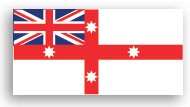
THE NATIONAL COLONIAL FLAG
The Anti-Transportation League flag
The Australasian Anti-Transportation League was formed to organise protests against the transportation of convicts from Britain to Australia and New Zealand. Its flag was flown at the League’s first meeting in Melbourne on 28 February 1851.
This flag is preserved at the Queen Victoria Museum and Art Gallery in Launceston. Made of silk, it measures about 274 centimetres by 366 centimetres. It has a deep blue background with the Union Jack in the canton and five stars arranged in the pattern of the Southern Cross.
The Union Jack is hand-sewn in rose-red, white and blue and the stars are gold. The five stars represent Tasmania, Victoria, New South Wales, South Australia and New Zealand. A white silk border runs across the top and bottom and the right‑hand side.
A gold inscription around the edges reads, ‘Australasian League, Tasmania, Instituted 1851’.
In 1853, when transportation ended, the League dissolved and its flag did not fly again.
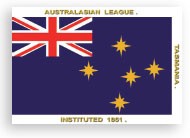
THE ANTI-TRANSPORTATION LEAGUE FLAG
The Murray River flag
Another unofficial flag, the Murray River flag, was flown on some of the paddle‑steamers that were part of the Murray River trade in the 1850s. Featuring the Southern Cross and stripes, this flag’s design was influenced by earlier flags such as the national colonial flag and the New South Wales merchant flag of the 1830s.
Today there are two versions of the Murray River flag which are flown from vessels travelling on the Murray River: the Upper Murray flag and the Lower Murray flag. The Upper Murray flag is the original flag design and is flown above Wentworth in New South Wales. The Lower Murray flag is a newer design based on the original flag and is flown below Wentworth and into South Australia.
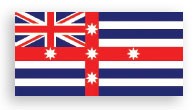
THE MURRAY RIVER FLAG
The Eureka flag
The Eureka flag is important because of its early use of the Southern Cross but not of the Union Jack. Some would claim the Eureka flag as the first ‘Australian’ flag of a distinctive design and differing from flags that had previously been used. The flag was plain blue with five white stars, one at the centre and one at each tip of a white cross.
The Eureka flag was that used by gold miners at the Eureka Stockade at Ballarat in Victoria from November 1854. At a meeting at Bakery Hill on 29 November that year, the miners raised the Eureka flag and swore an oath to fight to defend their rights. They were protesting against the expense of a Miner’s Licence Fee and other perceived political and economic injustices.
Although the miners lost the battle at the Eureka Stockade, they succeeded in having many oppressive laws repealed. This event played a part in the development of democracy in Australia. The original flag is kept at the Ballarat Fine Art Gallery.
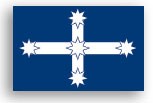
THE EUREKA FLAG
The Australian federation flag
In the 1880s and 1890s, the Australian federation flag was a popular symbol of the movement for federation of the six colonies. The flag featured the stars of the Southern Cross in white placed on a blue cross against a white background. In the canton was the Union Jack.
The design was based on the New South Wales ensign of the 1830s, which was a popular local banner until the 1890s, when it was adopted as the Australian federation flag. Also known as the Australian ensign, it was still seen as late as the 1920s.
Prime Minister the Right Hon Edmund Barton submitted it to the British authorities in 1902 as an alternative to the design chosen for the Australian National Flag through the 1901 competition.
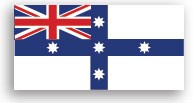
THE AUSTRALIAN FEDERATION FLAG
